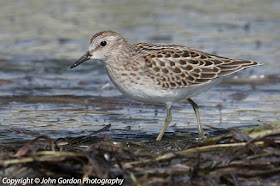Sept 27/28/29 Boundary Bay 96-104 St Delta BC.
If I ever thought flycatchers were difficult to identify then the American golden plover and its close cousin the Pacific golden plover come in a very close second.
The species can be next to impossible for the novice to identify and even experienced birders sometimes have to take a second look.
Even scoping in the company of experienced birders, identification can still be a challenge. Tell tale signs like the presence of the long wingtips on the American is diagnostic, while on the Pacific, tail feathers don't protrude beyond the tail. Simple Eh, Hmmm!
But what if the bird is facing you (most times they are) and to that add a mixture of juvenile adult non-breeding and adult breeding birds in the same flock then the challenge of identification become more difficult.
Just to confuse matters, telling Pacific and Americans apart (below) is again confused by some juvenile black-bellied plovers. Note the stout bill and the golden wash of the bird below, it tricked me for a moment into thinking it was the scarcer American golden plover.
 |
| Juvenile black-bellied plover with fresh plumage resulting a golden wash and streaked breast. |
Even with a scope, identification can be difficult. For the purpose of this blog I spent three evenings photographing all three species, but especially the rarer American and Pacific.
On each occasion I would check to see if there were any other birders around before I walked out to get a closer view. There weren't. The tide was far out so I walked along the beach until I spotted six plovers mixed in with a small flock of western sandpipers and dunlins. As I drew closer I could see that the plovers were more dainty and slimmer billed than the commoner black-bellied plovers. Besides they acted differently allowing me to creep up on them, something black-bellies won't normally allow. Americans and Pacific that mix-in with black-bellied are almost impossible to approach.
On each occasion I would check to see if there were any other birders around before I walked out to get a closer view. There weren't. The tide was far out so I walked along the beach until I spotted six plovers mixed in with a small flock of western sandpipers and dunlins. As I drew closer I could see that the plovers were more dainty and slimmer billed than the commoner black-bellied plovers. Besides they acted differently allowing me to creep up on them, something black-bellies won't normally allow. Americans and Pacific that mix-in with black-bellied are almost impossible to approach.
*****
Back home I had four birds books laid out on the table trying to work out which of the two species was which. I even posted my photos and only had two responses, both who erred on the cautious side. So, if you see I have mis-identified any of the pictures below please feel free to drop me an e-mail.
Often the American and Pacific goldens feed on the edge of the larger black-bellied plover flock.
 |
| American golden plover. |
 |
| Another day and another pair of American golden plovers. |
 |
| American golden plover. |
American -golden plovers feel more secure when hiding in the tussocks of grass at high tide.
 |
| Pacific-golden plover. |
 |
| (l-r) Pacific-golden plover, western sandpiper and dunlin. |
 |
| Pacific-golden plover. |
 |
| A better side-view of the Pacific-golden plover with retained alternate (breeding) plumage. |
Plovers are not the only birds on the beach. American Pipits have been passing through most of September. Sometime flocks of fifty gather in the fields while along the dike pairs can be seen feeding on insects, sometimes they feed alongside pectoral sandpipers.
 |
| American Pipit. |
 |
| American Pipits are often found in pairs. |
Meanwhile.....
Small flock of pectorals continue to feed right up to the edge of the dyke even when the water is way out.
 |
| Pectoral sandpiper. |
As the tide floods Western Sandpipers sit on flotsam to rest.
 |
| Western sandpipers. |
 |
| This sandpiper came so close I could almost touch it. |
 |
| Black-bellied plover are mostly gray overall and the commonest plover in Boundary Bay. |
Parting Shot
As the sun sets so does the quality of light. Often referred to as" sweet light" this light adds a golden wash to everything including this flock of black-bellied plovers which a few hours earlier (above) were gray in colour. Can you see identify the odd bird out?
An American golden plover (foreground) feeds on the mudflats of Boundary Bay.
|
"It's never too late to learn about plovers"
John Gordon
Langley/Cloverdale
BC Canada



























